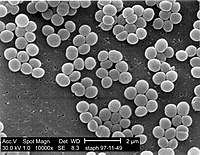
Photo from wikipedia
The aim of this research was to study the phenotypic resistances to disinfectants and antibiotics in strains of methicillin‐resistant Staphylococcus aureus (MRSA) obtained from Canary black pigs. Analyses were performed… Click to show full abstract
The aim of this research was to study the phenotypic resistances to disinfectants and antibiotics in strains of methicillin‐resistant Staphylococcus aureus (MRSA) obtained from Canary black pigs. Analyses were performed on 54 strains of MRSA, isolated in Canary black pigs from the province of Tenerife (Spain); all of them carried the mecA gene. The strains were isolated by means of nasal swab samples of healthy pigs, collected under veterinarian supervision. Bactericidal activity of antiseptics and disinfectants was tested by means of the dilution–neutralization method. Susceptibility to the disinfectants glutaraldehyde, peracetic acid and silver nitrate was assessed, as well as to the antiseptics chlorhexidine, benzalkonium chloride and povidone iodine. Susceptibility to a wide array of antibiotics representing the main groups was determined by means of the disc diffusion method. All the strains demonstrated susceptibility to the disinfectants tested at the recommended concentration, and even to dilutions equal to or lesser than 1/16. The most effective antiseptic and disinfectant were, respectively, chlorhexidine and silver nitrate. With regard to the antibiotics, the strains proved to be multiresistant. All presented phenotypic resistance to the β‐lactam antibiotics ampicillin, penicillin and cefoxitin, as well as to numerous aminoglycosides, tetracycline and trimethoprim–sulfamethoxazole. It was also observed that 61.1% of the strains were carriers of plasmids. Our results underline that in the strains such as MRSA, which show multiple resistances to antibiotics, the antiseptics and disinfectants show great efficacy. Moreover, as other authors also suggest, for the treatment and prevention of infections caused by MRSA, the use of β‐lactam and aminoglycoside antibiotics may be less effective.
Journal Title: Zoonoses and Public Health
Year Published: 2017
Link to full text (if available)
Share on Social Media: Sign Up to like & get
recommendations!